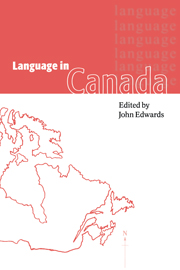Book contents
- Frontmatter
- Contents
- List of figures
- List of maps
- List of tables
- Notes on contributors
- 1 Canada
- Introduction
- 1 The foundations
- 2 The fading Canadian duality
- 3 Official bilingualism: from the 1960s to the 1990s
- 4 Official multiculturalism
- 5 Language in education: bridging educational policy and social psychological research
- 6 Aboriginal languages: history
- 7 Aboriginal languages: current status
- 8 French: Canadian varieties
- 9 French in Quebec
- 10 French in New Brunswick
- 11 French outside New Brunswick and Quebec
- 12 English: Canadian varieties
- 13 English Quebec
- 14 The teaching of international languages
- 15 French immersion in Canada
- 16 Language in Newfoundland
- 17 Language in Prince Edward Island
- 18 Language in Nova Scotia
- 19 Language in New Brunswick
- 20 Language in Quebec: aboriginal and heritage varieties
- 21 Language in Ontario
- 22 Language in Manitoba
- 23 Language in Saskatchewan: Anglo-hegemony maintained
- 24 Language in Alberta: unilingualism in practice
- 25 Language in British Columbia
- 26 Language in the Northwest Territories and the Yukon Territory
- Index of names
- Index of language families, languages, dialects
- Index of subjects
11 - French outside New Brunswick and Quebec
Published online by Cambridge University Press: 18 February 2010
- Frontmatter
- Contents
- List of figures
- List of maps
- List of tables
- Notes on contributors
- 1 Canada
- Introduction
- 1 The foundations
- 2 The fading Canadian duality
- 3 Official bilingualism: from the 1960s to the 1990s
- 4 Official multiculturalism
- 5 Language in education: bridging educational policy and social psychological research
- 6 Aboriginal languages: history
- 7 Aboriginal languages: current status
- 8 French: Canadian varieties
- 9 French in Quebec
- 10 French in New Brunswick
- 11 French outside New Brunswick and Quebec
- 12 English: Canadian varieties
- 13 English Quebec
- 14 The teaching of international languages
- 15 French immersion in Canada
- 16 Language in Newfoundland
- 17 Language in Prince Edward Island
- 18 Language in Nova Scotia
- 19 Language in New Brunswick
- 20 Language in Quebec: aboriginal and heritage varieties
- 21 Language in Ontario
- 22 Language in Manitoba
- 23 Language in Saskatchewan: Anglo-hegemony maintained
- 24 Language in Alberta: unilingualism in practice
- 25 Language in British Columbia
- 26 Language in the Northwest Territories and the Yukon Territory
- Index of names
- Index of language families, languages, dialects
- Index of subjects
Summary
INTRODUCTION
In this chapter I will examine various measures of the vitality of the francophone minorities living outside Quebec and New Brunswick. These will include information on the availability of French-medium schooling and other kinds of institutional support for French, and statistics on the French mothertongue population – e.g., retention of French at home, use of French in other domains of society, bilingualism in English, birth rate, rate of linguistic reproduction, etc. This examination will lead to an assessment of the chances of short- and longer-term survival of these francophone communities.
BRIEF HISTORY
The presence of about 750,000 French-speaking Canadians outside New Brunswick and Quebec can be traced back to two distinct sources. East of New Brunswick, in the provinces of Nova Scotia and Prince Edward Island, the great majority of francophones are of Acadian ancestry. In the province of Newfoundland, francophones who reside on the island are mostly of Acadian ancestry, while those in Labrador are chiefly of Québécois ancestry or are Quebec-born. Before being deported by Britain in 1755, Acadians had expanded beyond their original colony in Port-Royal, Nova Scotia (a settlement dating from 1605) to various regions of the Atlantic provinces (e.g., eastern New Brunswick, Prince Edward Island and Cape Breton).
- Type
- Chapter
- Information
- Language in Canada , pp. 226 - 251Publisher: Cambridge University PressPrint publication year: 1998
- 3
- Cited by



